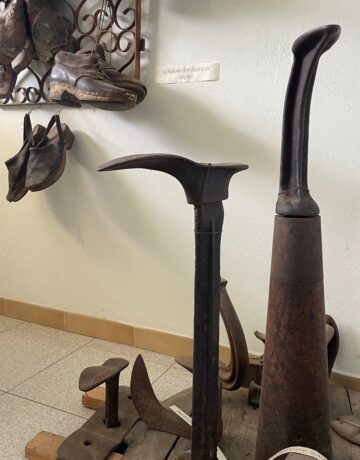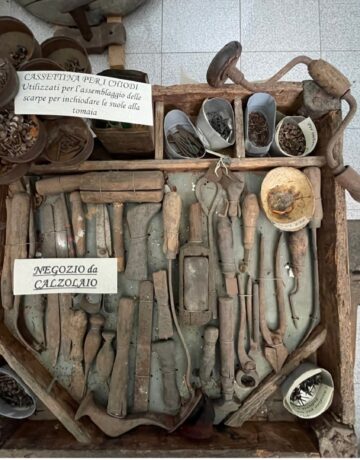The Shoemaker’s room
 In room #7, where the stairs end, has been recreated a typical room of a shoemaker, where numerous tools used in the past to manually make craft shoes are shown to the visitor.
In room #7, where the stairs end, has been recreated a typical room of a shoemaker, where numerous tools used in the past to manually make craft shoes are shown to the visitor.
You can appreciate the wooden shapes, the samples of shoes, old work boots and some boots.
Very characteristic are the tripods of all sizes, from child to adult, typical of the ancient craft, which were used to hammer the nails of shoe soles.
At the centre of the room there is a sewing machine and the banquet with all the tools for nailing, polishing and finishing the handicraft.
At the end of the visit, on the back wall of the room, you can admire a sample of the very particular and robust chair called “carabiniere“, lowered to support the work on the legs.
The shoemaker can be described as a craftsman who makes and repairs shoes and accessories, such as bags, belts and leather clothing.

Wooden footwears similar to those exposed in the room, obtained directly following the anatomy of the foot, are still used today for shoemaking production; then to obtain the shoe upper, you must cut out acardboard form. For this operation is used the piece of leather chosen and cut from the most suitable part and, at the end of the work, the measurements were noted.
To manufacture shoes were commonly used cowhide, sheepskin or goat leather.
The edges of elements composing the upper, were thinned by a process of edge reinforcement called “sparatura”, after which they were joined for hemming, bending the hammering and to finish were sewn with linen threads. Using again a mould, the soles were cut from pieces of leather previously wet and then left to dry slowly. After that, the leather sole was joined to the bottom of the upper by the pitch, a semi-solid sticky substance deriving from the residue of natural tar, so the heel and the over-heel were applied with a second stitching, at the end the shoe was polished.
